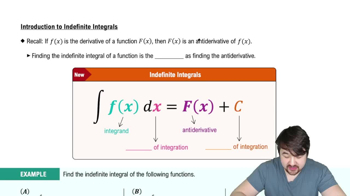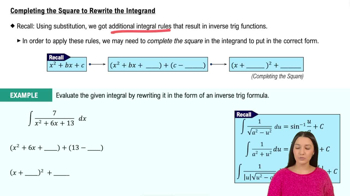Find the area under the curve of between and .
Table of contents
- 0. Functions7h 54m
- Introduction to Functions16m
- Piecewise Functions10m
- Properties of Functions9m
- Common Functions1h 8m
- Transformations5m
- Combining Functions27m
- Exponent rules32m
- Exponential Functions28m
- Logarithmic Functions24m
- Properties of Logarithms36m
- Exponential & Logarithmic Equations35m
- Introduction to Trigonometric Functions38m
- Graphs of Trigonometric Functions44m
- Trigonometric Identities47m
- Inverse Trigonometric Functions48m
- 1. Limits and Continuity2h 2m
- 2. Intro to Derivatives1h 33m
- 3. Techniques of Differentiation3h 18m
- 4. Applications of Derivatives2h 38m
- 5. Graphical Applications of Derivatives6h 2m
- 6. Derivatives of Inverse, Exponential, & Logarithmic Functions2h 37m
- 7. Antiderivatives & Indefinite Integrals1h 26m
- 8. Definite Integrals4h 44m
- 9. Graphical Applications of Integrals2h 27m
- 10. Physics Applications of Integrals 3h 16m
- 11. Integrals of Inverse, Exponential, & Logarithmic Functions2h 34m
- 12. Techniques of Integration7h 41m
- 13. Intro to Differential Equations2h 55m
- 14. Sequences & Series5h 36m
- 15. Power Series2h 19m
- 16. Parametric Equations & Polar Coordinates7h 58m
12. Techniques of Integration
Partial Fractions
Problem 8.7.21
Textbook Question
7–40. Table look-up integrals Use a table of integrals to evaluate the following indefinite integrals. Some of the integrals require preliminary work, such as completing the square or changing variables, before they can be found in a table.
21. ∫ cos x / (sin² x + 2 sin x) dx
 Verified step by step guidance
Verified step by step guidance1
Step 1: Begin by analyzing the denominator of the integrand, sin²(x) + 2sin(x). Notice that this expression can be rewritten by completing the square. Rewrite it as (sin(x) + 1)² - 1.
Step 2: Perform a substitution to simplify the integral. Let u = sin(x) + 1, which implies that du = cos(x) dx. This substitution transforms the integral into ∫ du / (u² - 1).
Step 3: Recognize that the new integral ∫ du / (u² - 1) matches a standard form found in a table of integrals. Specifically, it resembles the integral of 1 / (x² - a²), which has a known solution.
Step 4: Use the table of integrals to find the solution for ∫ du / (u² - 1). The result will involve logarithmic functions, specifically ln|u - 1| and ln|u + 1|.
Step 5: Substitute back u = sin(x) + 1 into the solution obtained from the table to express the final answer in terms of x. Simplify the expression if necessary.
 Verified video answer for a similar problem:
Verified video answer for a similar problem:This video solution was recommended by our tutors as helpful for the problem above
Video duration:
8mPlay a video:
Was this helpful?
Key Concepts
Here are the essential concepts you must grasp in order to answer the question correctly.
Indefinite Integrals
Indefinite integrals represent a family of functions whose derivative is the integrand. They are expressed without limits and include a constant of integration, typically denoted as 'C'. Understanding how to evaluate indefinite integrals is crucial for solving problems in calculus, as they provide the antiderivative of a function.
Recommended video:

Introduction to Indefinite Integrals
Integration Techniques
Various techniques are employed to evaluate integrals, including substitution, integration by parts, and using tables of integrals. In this case, recognizing the need for preliminary work, such as completing the square or changing variables, is essential to transform the integrand into a form that can be easily matched with entries in an integral table.
Recommended video:

Integration by Parts for Definite Integrals
Completing the Square
Completing the square is a method used to rewrite quadratic expressions in a specific form, which can simplify integration. This technique involves rearranging a quadratic expression into a perfect square trinomial plus a constant. It is particularly useful when dealing with integrals that contain quadratic terms in the denominator, as it can facilitate easier integration.
Recommended video:

Completing the Square to Rewrite the Integrand

 1:07m
1:07mWatch next
Master Partial Fraction Decomposition: Distinct Linear Factors with a bite sized video explanation from Patrick
Start learningRelated Videos
Related Practice
Multiple Choice
72
views
